by Amineddoleh & Associates LLC | May 26, 2017 |
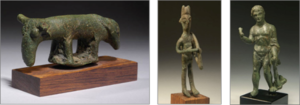
Yesterday Amineddoleh & Associates LLC had the honor of attending the repatriation ceremony for a collection of ancient artifacts returned to the Italian Republic. Manhattan District Attorney Cyrus R. Vance, Jr. recognized the importance of returning antiquities and honoring their repatriation with a ceremony and press release. He noted that the trade in looted objects signals the willingness of collectors and institutions to condone this harmful practice, and that efforts should be made to halt the trade in looted works. The seized pieces were returned to the Consul General of Italy in New York, Francesco Genuardi who thanked the DA for “achieving another important result in the fight against the international smuggling of antique artifacts.”
The role of Amineddoleh & Associates LLC in the ongoing federal seizures and repatriations is as an expert legal consultant on the topic of international cultural patrimony laws. The Republic of Italy arguably has the best laws protecting cultural patrimony, or at least some of the most stringent and protective ones. In addition, Italian law enforcement agents have been celebrated for their successful protection and recovery of artifacts. The Comando Carabinieri Tutela Patrimonio Culturale (the Carabinieri Headquarters for the Protection of Cultural Heritage) is the best trained and most successful unit protecting heritage sites, preemptively halting the plunder of heritage, and demanding the return of nationally owned objects.
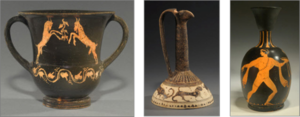 Yesterday’s repatriation ceremony after the seizure should be viewed as an example to collectors, dealers, and other art institutions. The US government treats these crimes seriously and will pursue the rightful return of plundered goods. Assistant District Attorney, and famed cultural heritage preservationist, Matthew Bogdanos, is a inspiring advocate for the rightful restitution of cultural property. During the ceremony, he spoke about the well-documented cultural plunder that occurred in Italy, and the impossibility of determining the number of objects that have been looted. Some have appeared on the art market, however many are still hidden in private and public collections. Congratulations to the US and Italian agents working on this case!
Yesterday’s repatriation ceremony after the seizure should be viewed as an example to collectors, dealers, and other art institutions. The US government treats these crimes seriously and will pursue the rightful return of plundered goods. Assistant District Attorney, and famed cultural heritage preservationist, Matthew Bogdanos, is a inspiring advocate for the rightful restitution of cultural property. During the ceremony, he spoke about the well-documented cultural plunder that occurred in Italy, and the impossibility of determining the number of objects that have been looted. Some have appeared on the art market, however many are still hidden in private and public collections. Congratulations to the US and Italian agents working on this case!
The repatriated objects will be displayed at the General Consulate of Italy in NY, and then displayed at museums located in Italy.
http://manhattanda.org/press-release/8th-century-bce-bronze-statues-among-collection-ancient-artifacts-being-repatriated-it
http://english.alarabiya.net/en/variety/2017/05/26/US-returns-stolen-archeological-artifacts-to-Italy-.html
http://www.kiro7.com/news/looted-statues-pottery-returned-to-italy-after-probe-in-nyc/526609581
by Amineddoleh & Associates LLC | Oct 4, 2016 |
The past week has been an art lawyer’s dream, with major news items about cultural heritage destruction, the recovery of stolen art, a lawsuit against a major museum, and the rediscovery of a painting by an Old Master.
Cultural Heritage Destruction and Crimes
Last Tuesday, cultural heritage made the headlines. Ahmad al-Faqi al-Mahdi faced a war crimes charge under Article 25 of the Rome Statute. This is the first time the International Criminal Court (ICC) had attempted to prosecute the “destruction of buildings dedicated to religion and historical monuments” as a war crime. In August, the trial against Al-Mahdi opened before Trial Chamber VIII at the ICC in The Hague, the Netherlands. The Malian national admitted guilt as to the war crime consisting of the destruction of historical and religious monuments in Timbuktu, Mali in 2012. He “exercised joint control over the attacks” by planning, leading and participating in them, supplying pick-axes and in one case a bulldozer.
Al-Mahdi expressed remorse for his involvement in the destruction of 10 mausoleums and religious sites in Timbuktu dating from Mali’s 14th-century golden age as a trading hub and center of Sufi Islam, a branch of the religion seen as idolatrous by some hardline Muslim groups. It was the first international trial focusing on the destruction of historical and religious monuments, and the first ICC case where the defendant admitted guilt. Last Tuesday, al-Mahdi was given 9 years in prison for his crimes. In handing down a 9-year sentence, rather than the maximum of 30 years, the judges stated that they took into account al-Mahdi’s “genuine remorse, deep regret and deep pain” and his calls on other Muslims not to make the same mistakes he had made.
Recovery of Stolen Art

Courtesy of the Van Gogh Museum, Amsterdam
On Friday, another major art announcement was made—two stolen Van Gogh paintings were recovered by Italian military police, the Carabinieri. The paintings were stolen in 2002 from the Van Gogh Museum in Amsterdam when two art thieves used a ladder to climb up to the roof of the museum, and broke into the building. The pair stole two paintings, View of the Sea at Scheveningen and Congregation Leaving the Reformed Church in Nuenen.
Last week, the paintings were recovered in Naples, Italy when authorities found the works after a sting operation to infiltrate an organized crime group, the Camorra. The paintings were stored in one of the houses of an international drug trafficker. According to press release from the Van Gogh Museum, the seascape has a patch of damage on the bottom left corner, but otherwise the paintings are in good condition. It is not known when the works will return to the Netherlands since they will likely be used as evidence in a trial.
Lawsuit against the Metropolitan Museum of Art
On Friday, the Metropolitan Museum of Art was sued over one of its most valuable Picasso works, The Actor. The estate of a German Jewish businessman, Paul Leffmann, asserts that the museum does not have good title to the painting because Leffmann was forced to sell it at a low price after fleeing the Nazis. The estate claims that the sale was made under duress. The law firm for the estate, Herrick Feinstein alleged in the court filing that the museum “did not disclose or should have known that the painting had been owned by a Jewish refugee, Paul Leffmann, who had disposed of the work only because of Nazi and Fascist persecution.” The lawyers said they had negotiated with the Met for several years, while the Met investigated the claim, but they had never been able to reach a settlement. The museum asserts the Leffmanns had made no claim on the painting after the war, when they did try to reclaim property they had been forced to sell.
Rediscovery of a Raphael
 And finally, on Sunday, an interesting attribution matter was announced in the news. A painting likely to be the work of Raphael was ‘rediscovered’ in the Haddo House, in Scotland. The painting of Madonna was obscured by darkened varnish and was misattributed to a minor hand. In 1899, it was valued as a copy for just about $25 dollars. If it is truly a Raphael, it would be worth about $25 million today.
And finally, on Sunday, an interesting attribution matter was announced in the news. A painting likely to be the work of Raphael was ‘rediscovered’ in the Haddo House, in Scotland. The painting of Madonna was obscured by darkened varnish and was misattributed to a minor hand. In 1899, it was valued as a copy for just about $25 dollars. If it is truly a Raphael, it would be worth about $25 million today.
Famous art historian Bendor Grosvenor was at the Haddo House to view other paintings for a BBC television series when he was struck by the Raphael tucked away in the corner. He discovered that the painting was bought as a Raphael in the early 19th century and exhibited as such in 1841. Afterwards, it was downgraded to “after Raphael”, and eventually attributed to a minor Renaissance artist, Innocenzo Francucci da Imola.
The story of this Raphael rediscovery will be featured on 5 October in a new BBC4 series, Britain’s Lost Masterpieces, co-presented by Grosvenor.
by Amineddoleh & Associates LLC | Jun 10, 2015 |
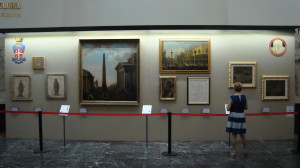
While working in Rome, I’ve had an opportunity to visit a new exhibit, “The Chest of Stolen Treasures,” at the Carabinieri Museum. The small exhibition features objects recently recovered by the Carabinieri after they were illegally exported from Italy. Interestingly, most of the objects (whether fine art pieces or antiquities) have a connection with New York dealers or Swiss collectors, demonstrating that the sale of illicit objects in these two notorious art markets continues. The majority of the works were recovered in New York and were returned to Italian officials earlier this spring. A debt of gratitude is owed to the Carabinieri who diligently pursue restitution of stolen art and cultural objects.
Castel Sant’Angelo also currently features an exhibit related to art either purchased by or returned to the Italian State. The exhibit, “Lo Stato dell’Arte—L’Arte dello State” (“State of the Art—Art of the State”), highlights objects acquired by the Ministry of Culture. When viewed together, the collections provide a snapshot of cultural heritage protection and administration in Italy: Italy’s efforts to protect and reacquire objects (either through law enforcement action or purchase) provide the nation with the ability to successfully demonstrate its rich artistic heritage.
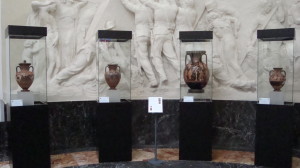
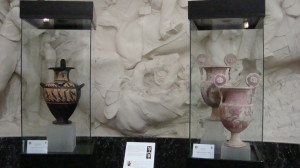
by Amineddoleh & Associates LLC | Mar 3, 2015 |
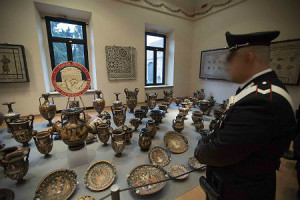 The start of 2015 has been triumphant for the Italian Carabinieri’s Tutela Patrimonio Culturale (http://www.carabinieri.it/cittadino/tutela/patrimonio-culturale/introduzione), the organization’s cultural heritage task force, known as its “Art Squad.” In January, it was announced that a cache of antiquities, valued at $58 million were recovered in Switzerland. (http://nypost.com/2015/01/21/italy-unveils-record-58m-haul-of-antiquities-from-swiss-raids/) The looted works had been smuggled from Italy across the border over the past decade. The Carabinieri, Italy’s military police, recovered rare antiquities seized during raids by Swiss police in Basel at the warehouses of a well-known Sicilian art dealer, Gianfranco Becchina. Becchina is infamous in the cultural heritage realm for his role in the black market antiquities trade, and was profiled in the book “The Medici Conspiracy.” According to a Carabinieri official, Mariano Mossa, “This is by a long shot the biggest recovery in history in terms of the quantity and quality of the archaeological treasures.” The recovery was celebrated internationally with the release of photos of a large storeroom of recovered treasures.
The start of 2015 has been triumphant for the Italian Carabinieri’s Tutela Patrimonio Culturale (http://www.carabinieri.it/cittadino/tutela/patrimonio-culturale/introduzione), the organization’s cultural heritage task force, known as its “Art Squad.” In January, it was announced that a cache of antiquities, valued at $58 million were recovered in Switzerland. (http://nypost.com/2015/01/21/italy-unveils-record-58m-haul-of-antiquities-from-swiss-raids/) The looted works had been smuggled from Italy across the border over the past decade. The Carabinieri, Italy’s military police, recovered rare antiquities seized during raids by Swiss police in Basel at the warehouses of a well-known Sicilian art dealer, Gianfranco Becchina. Becchina is infamous in the cultural heritage realm for his role in the black market antiquities trade, and was profiled in the book “The Medici Conspiracy.” According to a Carabinieri official, Mariano Mossa, “This is by a long shot the biggest recovery in history in terms of the quantity and quality of the archaeological treasures.” The recovery was celebrated internationally with the release of photos of a large storeroom of recovered treasures.
Then last week, it was reported by the NY Times and international news sources that a stolen Etruscan statuette and a Tiepolo painting, “The Holy Trinity Appearing to Saint Clement,” was returned to Italy. (http://artsbeat.blogs.nytimes.com/2015/02/24/federal-officials-return-tiepolo-painting-and-etruscan-bronze-to-italy/?_r=0) The painting was stolen from a home in Turin in 1982, and went missing for decades. It appeared at auction in New York in January 2014. After being informed that the work was stolen, the consignor agreed to its seizure and return. Italian authorities are currently investigating the circumstances surrounding the theft and importation into the US. The Etruscan statuette was stolen, along with other artifacts, from an archaeological museum in Pesaro in 1964. The object was exchanged multiple times through the years, and was recently offered for sale at auction in New York. This consignor was also informed of the work’s problematic past, and agreed to the seizure and repatriation.
February also witnessed the return of 200,000 euros worth of looted cultural objects located in an agriturismo in the Umbrian village of Norcia. (http://roma.repubblica.it/cronaca/2015/02/25/foto/reperti_rubati_a_roma_e_trovati_incastonati_in_un_agriturismo-108180045/1/#1) Artifacts from the Catacomb of San Callisto were looted from the early Christian catacomb and were found incorporated into architectural elements of the Umbrian hotel. They are currently in the custody of Italian authorities.
And the final news headline involving Italian cultural objects was the return of 17th century books found in California. (http://www.latimes.com/local/lanow/la-me-ln-400-year-old-books-italy-20150227-story.html) The two books were stolen from a library in Italy and sold to an American buyer unaware of the volumes’ origins. Interestingly, the buyers claim to have purchased the books from a reputable source, and they even received documentation of the legality of the sale. In compliance with due diligence standards, the buyers assert that they received provenance information and export documents from the Italian authorities. It has not yet been reported whether this documentation is fake, but the buyer has willingly forfeited the items.
These recoveries demonstrate the necessity for cooperation amongst international law enforcement agencies, and aptly display why the Carabinieri has become so lauded in the field of cultural heritage preservation.

 Yesterday’s repatriation ceremony after the seizure should be viewed as an example to collectors, dealers, and other art institutions. The US government treats these crimes seriously and will pursue the rightful return of plundered goods. Assistant District Attorney, and famed cultural heritage preservationist, Matthew Bogdanos, is a inspiring advocate for the rightful restitution of cultural property. During the ceremony, he spoke about the well-documented cultural plunder that occurred in Italy, and the impossibility of determining the number of objects that have been looted. Some have appeared on the art market, however many are still hidden in private and public collections. Congratulations to the US and Italian agents working on this case!
Yesterday’s repatriation ceremony after the seizure should be viewed as an example to collectors, dealers, and other art institutions. The US government treats these crimes seriously and will pursue the rightful return of plundered goods. Assistant District Attorney, and famed cultural heritage preservationist, Matthew Bogdanos, is a inspiring advocate for the rightful restitution of cultural property. During the ceremony, he spoke about the well-documented cultural plunder that occurred in Italy, and the impossibility of determining the number of objects that have been looted. Some have appeared on the art market, however many are still hidden in private and public collections. Congratulations to the US and Italian agents working on this case!
 And finally, on Sunday, an interesting attribution matter was announced in the news. A painting likely to be the work of Raphael was ‘rediscovered’ in the Haddo House, in Scotland. The painting of Madonna was obscured by darkened varnish and was misattributed to a minor hand. In 1899, it was valued as a copy for just about $25 dollars. If it is truly a Raphael, it would be worth about $25 million today.
And finally, on Sunday, an interesting attribution matter was announced in the news. A painting likely to be the work of Raphael was ‘rediscovered’ in the Haddo House, in Scotland. The painting of Madonna was obscured by darkened varnish and was misattributed to a minor hand. In 1899, it was valued as a copy for just about $25 dollars. If it is truly a Raphael, it would be worth about $25 million today.


